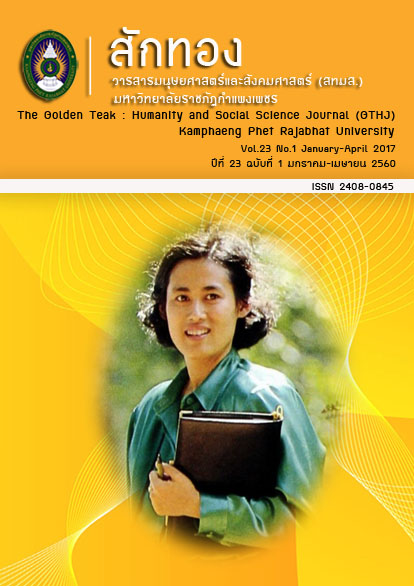ฟ้อนนกกิ่งกะหล่า : ครูส่างคำ จางยอด
Main Article Content
Abstract
บทคัดย่อ
การวิจัยนี้วัตถุประสงค์ เพื่อศึกษาประวัติความเป็นมาของการแสดงฟ้อนนกกิ่งกะหล่า ของชาวไทยใหญ่ รวมทั้ง ศึกษารูปแบบการแสดงฟ้อนนกกิ่งกะหล่า ของครูส่างคำ จางยอด และเพื่อศึกษาบทบาทหน้าที่ของการฟ้อนนกกิ่งกะหล่าในวิถีชีวิตของชาวไทยใหญ่ ผลการวิจัยพบว่า การแสดงฟ้อนนกกิ่งกะหล่าเป็นการแสดงที่มาจากการบอกเล่าสืบต่อกันมา การแสดงนี้เป็นการเลียนแบบอากัปกิริยา ของสัตว์ในป่าหิมพานต์ คือ กินรี ที่ออกมาฟ้อนรำ เพื่อถวายเป็นพุทธบูชา ในวันที่พระพุทธเจ้าเสด็จกลับมาหลังจากพระองค์เสด็จไปจำพรรษาจากสวรรค์ชั้นดาวดึงส์ โดยรูปการแสดงฟ้อนนกกิ่งกะหล่าของ ครูส่างคำ จางยอดที่ผู้วิจัยได้ศึกษานั้น เป็นการแสดงประกอบดนตรีจากกลองก้นยาว ฆ้องราว และฉาบ บรรเลงอัตราจังหวะที่มีความเร็วตายตัว สม่ำเสมอ ท่าฟ้อน มีทั้งหมด จำนวน 10 ท่า จำแนกเป็นท่าหลัก จำนวน 8 ท่า ได้แก่ 1) ท่าแม่ปอดแหวน 2) ท่าไหว้ครู 3) ท่าแม่แพด 4) ท่าแม่ฮอมมือ 5) ท่าแม่ยุ่งตา 6) ท่าแม่หมอกนอนเครือ 7) ท่าแม่สอดสอยข้าง และ8) ท่าแม่สอดสอยฟ้า ท่าเชื่อมจำนวน 1 ท่า คือ ท่าตั้งตัว และท่าจบ จำนวน 1 ท่า คือท่าจบ การแต่งกายประกอบด้วยชุดแต่งกาย 2 ส่วน คือ ส่วนตัวนก และส่วนหัวนก นิยมแสดงในงานมงคลต่างๆ ของชาวไทยใหญ่ โดยเฉพาะที่เกี่ยวข้องด้านศาสนา
Ginggala Bird Dance : Saangkham Jangyod
ABSTRACT
The objective of this research is to study about the history and origin of Ginggala Bird Dance which belongs to Tai Yai (a group of local people in the North of Thailand), the pattern of Ginggala Bird Dance : Saangkham Jangyod, and the importance of the dance in the Tai Yai’s way of life. The findings of the study show that Fon Nok Gingkalah is a performance which was passed down from generation to generation. It is imitated from animal gestures in Himmapan forest (the imaginary forest), like the Kinnaree (female bird with a human head). From the legend, a group of Kinnarees dance to pay respect to the Lord Buddha on the day that he comes back from the second heaven where Indra dwells. The study of the pattern of Fon Nok Gingkalah of Sangkum Jangyod found that the performance uses local musical instruments; Klong Kon Yao (a kind of drum), Khong Rao, and cymbal. The meter of the rhythm is played consistently. There are 10 postures which are divided to be the main ones ; 1)Tah Mea Bod Van 2)Tah Wai Kru 3)Tah Mae Paed 4)Tah Mae Hom Mue 5)Tah Mae Yung Ta 6)Tah Mae Mok Non Krua 7)Tah Mae Sot Soi Kang and 8)Tah Mae Sot Soi Fah. There is one movement to connect is called Tah Tang Tuah and one ending step is called Tah Jub.. The costumes consist of 2 parts which are the body and the head of the bird. Fon Nok Gingkalah is performed to celebrate the special events of the Tai Yai. It is believed that it is shown to serve the community and is based in religion.
Article Details
บทความที่ได้รับการตีพิมพ์เป็นลิขสิทธิ์ของวารสาร สักทอง : วารสารมนุษยศาสตร์และสังคมศาสตร์ สถาบันวิจัยและพัฒนา มหาวิทยาลับราชภัฏกำแพงเพชร
ข้อคิดเห็นใดๆ ที่ปรากฎในวารสารเป็นวรรณกรรมของผู้เขียนโดยเฉพาะ ซึ่งมหาวิทยาลัยราชภัฏกำแพงเพชรและบรรณาธิการไม่จำเป็นต้องเห็นด้วย


